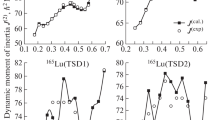Abstract
The phenomenon of identical bands is studied by analyzing the distributions of fractional changes in the dynamical moments of inertia of pairs of bands in superdeformed (SD) nuclei. These distributions are found to exhibit a peak with a centroid at nearly zero. Their widths increase in going from the SD bands in the massA∼150, to the SD bands in the mass ∼190 and to the normally-deformed bands in the rare-earth region. These differences may be attributed to the weaker pairing correlations and the stabilizing role of intruder orbitals on the structures of SD bands. Precise level lifetimes have been measured for various pairs of identical SD bands in Gd and Dy isotopes. By comparing the derived quadrupole moments with calculations performed in the framework of the cranking Skyrme-Hartree-Fock model, it is shown that, independently of the intrinsic configuration and of the proton and neutron numbers, the charge moments calculated with respect to the doubly-magic SD core of152Dy can be expressed in terms of independent contributions from the individual hole and particle orbitals.
Similar content being viewed by others
References
C. Baktash, B. Haas and W. Nazarewicz,Ann. Rev. Nucl. Part. Sci. 45 (1995) 485.
T. Byrski et al.,Phys. Rev. Lett. 64 (1990) 1650.
W. Nazarewicz et al.,Phys. Rev. Lett. 64 (1990) 1654.
F.S. Stephens,Nucl. Phys. A520 (1990) 91c.
F.S. Stephens et al.,Phys. Rev. Lett. 66 (1991) 1378.
I. Ahmad et al.,Phys. Rev. C45 (1991) 1204.
R.F. Casten et al.,Phys. Rev. C45 (1992) R1413.
C. Baktash et al.,Phys. Rev. Lett. 69 (1992) 1500.
G. de France et al.,Phys. Rev. C53 (1996) 1070.
C. Baktash et al.,Nucl. Phys. A557 (1993) 145c.
References to experimental bands used in this study can be found in the review [1] C. Baktash, B. Haas and W. Nazarewicz,Ann. Rev. Nucl. Part. Sci. 45 (1995) 485.
W. Nazarewicz, R. Wyss and A. Johnson,Nucl. Phys. A503 (1989) 285.
Y.R. Shimizu, E. Vigezzi and R.A. Broglia,Nucl. Phys. A509 (1990) 80.
T. Bengtsson, S. Åberg and I. Ragnarsson,Phys. Lett. 208B (1988) 39.
I. Ragnarsson,Nucl. Phys. A557 (1993) 167.
See Ref. [17] P. Fallon et al., inProc. Conf. on Physics from Large γ-Ray Arrays, Lawrence Berkeley Laboratory Report LBL-35687, Berkeley, 1994, Vol. II, pp. 89–93.
P. Fallon et al., inProc. Conf. on Physics from Large γ-Ray Arrays, Lawrence Berkeley Laboratory Report LBL-35687, Berkeley, 1994, Vol. II, pp. 89–93.
see Refs [19–21]. W. Satula et al.,Nucl. Phys. A529 (1991) 289. B. Gall et al.,Z. Phys. A348 (1994) 183.
M.A. Riley et al.,Nucl. Phys. A512 (1990) 178.
W. Satula et al.,Nucl. Phys. A529 (1991) 289.
B. Gall et al.,Z. Phys. A348 (1994) 183.
D. Ye et al.,Phys. Rev. C41 (1990) R13.
M.A. Bentley et al.,Phys. Rev. Lett. 59 (1987) 2141.
B. Cederwall et al.,Nucl. Instr. Meth. A354 (1995) 591.
B. Haas et al.,Phys. Rev. Lett. 60 (1988) 503.
P. Fallon et al.,Phys. Lett. B257 (1991) 269.
H. Savajols et al.,Phys. Rev. Lett. 76 (1996) 4480.
C. Rigollet et al., PhD thesis (1996) and to be published.
S. Flibotte et al.,Nucl. Phys. A584 (1995) 373.
G. de Angelis et al., inProc. Conf. Phys. Large γ-Ray Arrays, Lawrence Berkeley Lab. Rep. LBL-35687, 1994.
G. de France, inInternational Spring Seminar on Nuclear Physics, New Perspectives in Nuclear Structure, Ravello, Italy, 1995.
F.A. Beck, inProc. Conf. Phys. Large γ-Ray Arrays, Lawrence Berkeley Lab. Rep. LBL-35687, 1994.
L.C. Northcliffe and R.F. Schilling,Nucl. Data Tables 7 (1970) 256.
S.H. Sie et al.,Nucl. Phys. A291 (1977) 443.
J. Lindhard, M. Scharff and H.E. Schiott,Mat. Fys. Medd. Dan. Vid. Selk. 33, No. 14 (1963).
K.B. Winterbon,Atomic Energy of Canada Limited Report, AECL-3194 (1968).
A.E. Blaugrund,Nucl. Phys. 88 (1966) 501.
J.C. Bacelar et al.,Phys. Rev. C35 (1987) 1170.
J. Gascon et al.,Nucl. Phys. A513 (1990) 344.
J.F. Ziegler, J.P. Biersack and U. Littmark,The Stopping and Range of Ions in Solids, Pergamon, New York, 1985.
B. Haas et al.,Nucl. Phys. A561 (1993) 251.
W. Satula, J. Dobaczewski, J. Dudek and W. Nazarewicz,Phys. Rev. Lett. 77 (1996) 5168.
Author information
Authors and Affiliations
Rights and permissions
About this article
Cite this article
Haas, B. Identical superdeformed bands. APH N.S., Heavy Ion Physics 6, 205–218 (1997). https://doi.org/10.1007/BF03158498
Received:
Issue Date:
DOI: https://doi.org/10.1007/BF03158498




